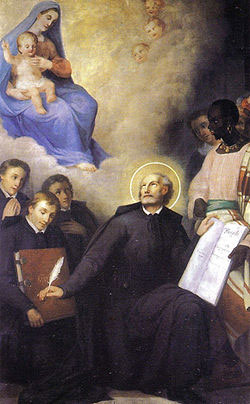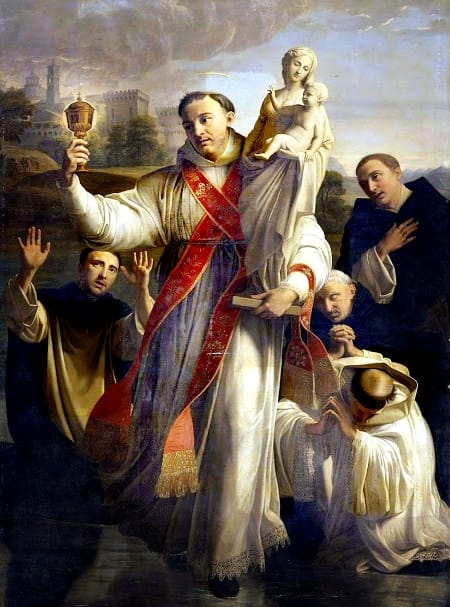"Before his death he called for all his children, gave them excellent instructions with his blessing, and asked pardon of all the world if ever he had given offence to any. In his agony, holding a blessed taper in his hands, he recommended his soul to God through the merits of his crucified Redeemer in the most pathetic aspirations; then caused the clergy to recite near him the Litanies, and afterwards the Te Deum. This was scarcely finished when he yielded up his soul into the hands of his Creator on the 30th of May, 6 in the year 1252, the fifty-third of his age, the thirty-fifth of his reign in Castile, and the twenty-second in Leon. According to his desire he was buried before the image of our Lady in the great church at Seville, and his body is still preserved in that church in a rich shrine without the least blemish of corruption, and has been honoured with miracles."
The Traditional Matins Reading for where his feast is celebrated:
Ferdinand the Third, king of Castile and Leon, to whom, for now four centuries, the title of saint has been given both by clergy and laity, exhibited so much prudence in his youthful years, that his mother Berengaria, queen of Castile, who had educated him in a very holy manner, resigned her kingdom in his favour. Scarcely had Ferdinand assumed the government, than he displayed conspicuously all the virtues becoming a king: magnanimity, clemency, justice, and above ail, zeal for Catholic faith and worship, which he ardently defended and propagated. He mainly showed this zeal by forbidding heretics to settle in his states. He also gave proofs of it by building, endowing, and dedicating to Christian worship, churches in Cordova, Jaen, Seville, and other cities rescued from the Moorish yoke. He restored, with holy and royal munificence, the Cathedrals of Toledo, Burgos, and other cities.
At the same time, he levied powerful armies in the kingdom of Castile and Leon, which he inherited from his father Alphonsus; and, each year, gave battle to the Saracens, the enemies of the Christian religion. The great means whereby this most holy king secured victory in every engagement, were the prayers he offered up to God: he used also to chastise his body with disciplines and a rough hair-shirt, with the intention of rendering God propitious. By so doing, he gained extraordinary victories over the mighty armies of the Moors, and, after taking possession of Jaen, Cordova, and Murcia, and making a tributary of the kingdom of Granada, he restored many cities to the Christian religion and to Spain. He led his victorious standard before Seville, the capital of Baeza, being, as it is related, urged thereto by St Isidore, who had formerly been bishop of that city, and who appeared to him in a vision. Historians also relate that he was miraculously aided during that siege, and in the following manner: The Mahometans had stretched an iron chain across the Guadalquivir, in order to block up the passage. Suddenly there arose a violent wind, and one of the royal ships was, by the king’s order, sent against the chain, which was thus broken, and with so much violence that it was carried far on, and bore down a bridge of boats. The Moors lost all their hope, and surrendered the city.
Ferdinand attributed all these victories to the patronage of the Blessed Virgin Mary, whose image he always had in his camp, and honoured it with much devotion. Having taken Seville, his first thoughts were directed to religion. He immediately caused the Mosque of the Saracens to be purified and dedicated as a Christian church, having, with a princely and pious munificence, provided it with an archiepiscopal see, richly endowed, as also with a well-appointed college of Canons and dignitaries. He moreover built several other churches and monasteries in the same city. Whilst engaged in these holy works, he was making preparations to pass over to Africa, there to crush the Mahometan empire; but he was called to the kingdom of heaven. When his last hour came, he fastened a cord round his neck, prostrated on the ground, and, shedding abundant tears, adored the Blessed Sacrament which was brought to him as Viaticum. Having received it in admirable dispositions of reverence, humility and faith, he slept in the Lord. His body, which has remained incorrupt for six centuries, is buried in a tomb of extraordinary richness, in the Cathedral Church of Seville.




























